An abundance of seasonal fruits is a sure sign that summer has arrived. Cantaloupe is a beautiful and useful fruit that can be added to any garden. With patience, care, and a little luck, you can cultivate this delicious melon in your backyard. These tried-and-true strategies work quickly. Below we learn how to grow cantaloupe plants faster, the best tips to increase flowering, fruiting, and cantaloupe yield in your home garden, and how to harvest cantaloupe plants.
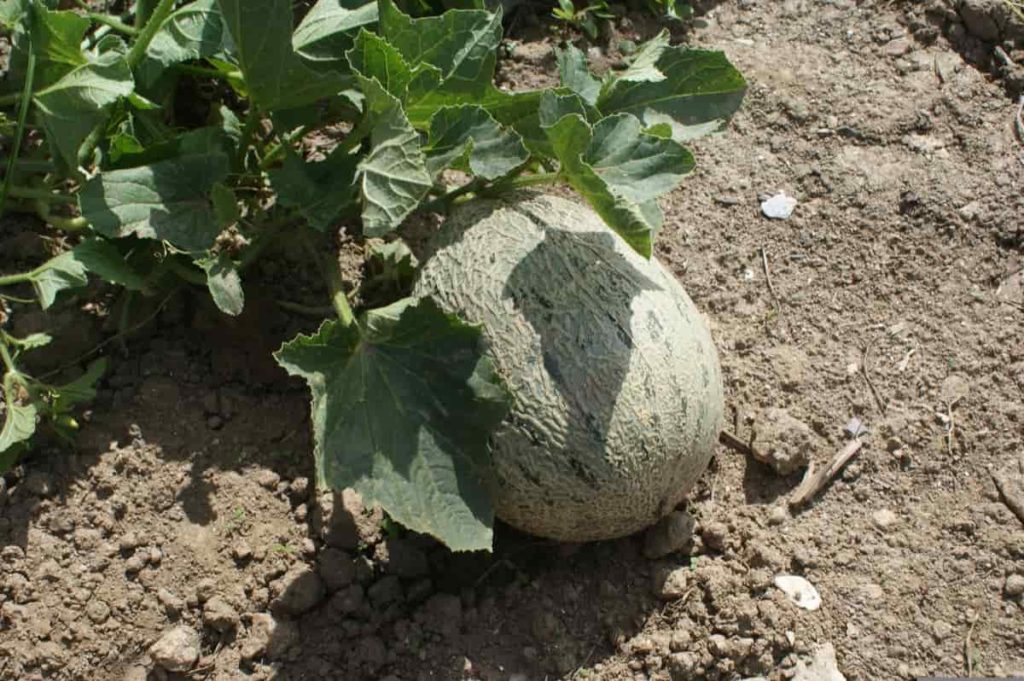
How to grow cantaloupe faster
Know when to plant your cantaloupe plants
Starting seeds indoors in containers for later transplanting can be done four weeks before the average last frost date in your area. Since cantaloupe grows best in warm conditions, it shouldn’t be planted until the springtime weather has stabilized. When growing cantaloupe, direct sowing yields the greatest results.
Plant seeds in the ground around two weeks after the last expected frost, when the soil temperature has reached approximately 65 degrees Fahrenheit. Plant seeds inside in colder zones three weeks before the last frost date, then move them outdoors whenever the soil is at least 65 degrees Fahrenheit and the nightly temperature is above 50 degrees Fahrenheit. Planting carefully can reduce the likelihood of transplant shock.
Choose the right spot
Cantaloupes like bright, sunny locations with soil that drains well. Cultivating plants in containers is possible, but you’ll need a large one. It’s best to separate your cantaloupe and watermelon plants from one another.
Provide the right soil and light for your cantaloupe plants
Plant seeds at a depth of about one inch. Put them in rows about three feet apart and 18 inches apart individually. No necessary framework can be found. However, a strong trellis or other support can guide the vines upward. As a bonus, this will help keep the soil free of harmful organisms and free up valuable real estate.
In case you missed it: How to Grow Watermelon Faster: Best Tips to increase Flowering, Fruiting, and Production Yield
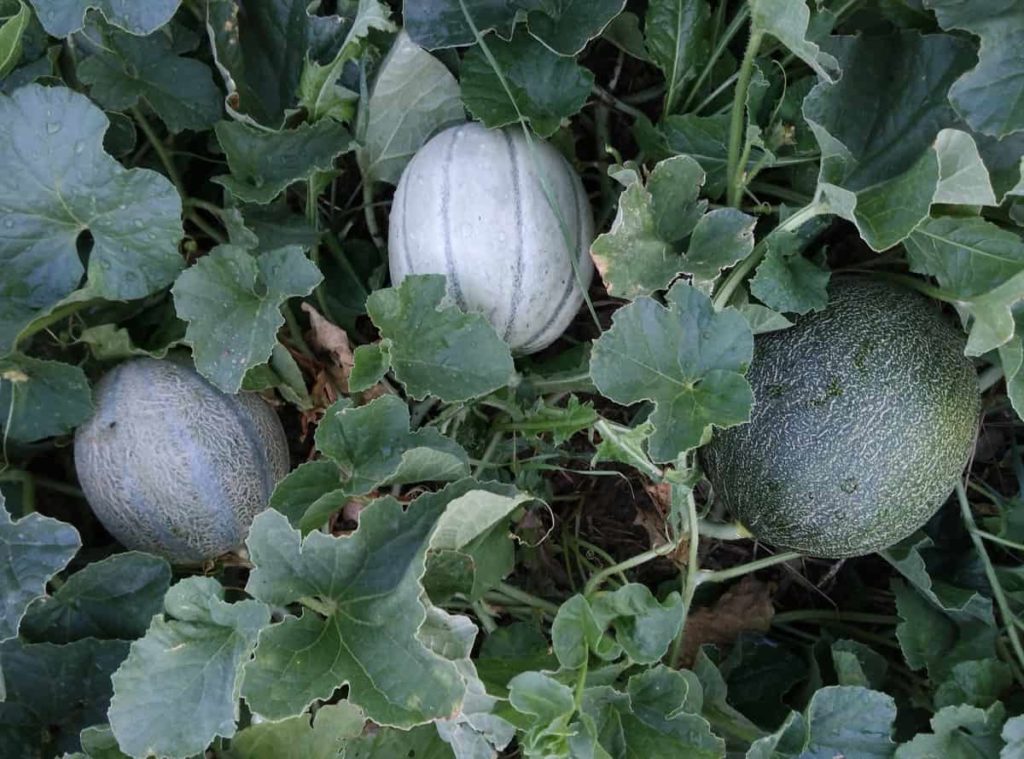
For optimal development, cantaloupe must be exposed to sunlight for at least 6 hours every day. Cantaloupe thrives on a soil composition equal to loamy and sandy, with a pH range from slightly acidic to neutral. It needs to drain quickly and efficiently. Before you plant, you may want to add compost to the soil to optimize its drainage and nutritional content.
Right planting of seeds is necessary.
Seeds should be indoors in colder areas four weeks before the typical last frost date. Due to the lengthy maturation period and growth time needed for melons, starting early increases the likelihood that you will be able to pick your crop before the first frost of autumn kills the plants. When the threat of frost has gone, seeds can be sown outside immediately in regions where temperatures seldom drop below freezing. Consider the average time of 65–90 days needed for most cantaloupe varieties to mature after planting.
When planting seeds in seed trays, fill each cell with high-quality potting soil and create a 1/2-inch deep hole in the soil with your finger. Put two or three seeds in each one, and make sure the pointed ends are facing down. Even if you turn the seed over and it germinates, the seedling will have a tougher time determining which way is up and which is down since roots sprout from the tip. Once you’ve misted or watered the seed with a watering can tap the soil back down over it.
The ideal humidity for seed germination may be achieved by covering your seed trays with a lid. A plastic wrap covering will have the same effect but must be removed as soon as the seeds germinate. The soil temperature should be kept at about 70 degrees Fahrenheit for optimal germination; a heat mat can help. Cantaloupe seedlings need consistent watering throughout their first several days, so keep that spray bottle handy.
A single germinated seedling should be left in each cell a few days after it has emerged. A sunny window sill or grow light is ideal for housing your seed trays. Hardening off for 7-10 days is necessary before putting them outside once they have developed two or three pairs of genuine leaves. Quick note: if you plant the seedlings upside down, the seed casings may not fall out right away as the seedling emerges from the soil.
If the coverings don’t shed on their own after a few days, you can remove them by gently pulling on them with your fingertips. It can stunt the plant’s development if you forget to remove them. Once the risk of frost has gone, those of you who live in warmer areas can go ahead and direct sow outside in the sun. Outdoors, put three seeds in holes 18-24 inches apart and 1/2 an inch deep. Maintain a consistent moisture level till germination.
In case you missed it: How to Grow Peas Faster: Best Tips to Increase Flowering, Fruiting, and Production Yield
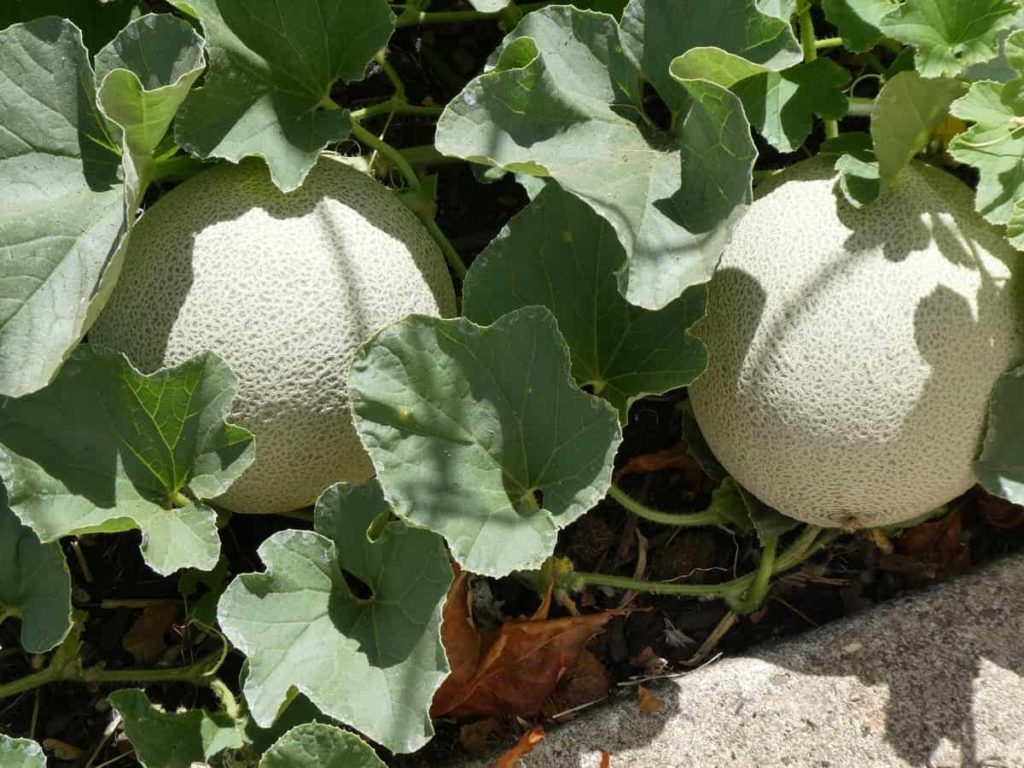
Start from transplants
Melons need between eight and ten hours of direct sunlight each day to reach their maximum potential as a crop. The soil in your raised beds or traditional row garden has to be prepared for the melons by being loose, well-draining, and fertile. After that, fill the hole you dug with soil, set the plant inside, and water it well. Plants should be separated by 18 to 24 inches.
The right temperature and humidity are also essential
The optimum crop results from temperatures that hover steadily between 70 and 90 degrees Fahrenheit throughout the growing season. Cantaloupe plants can’t handle cold weather. In addition, if the temperature rises beyond 90 degrees Fahrenheit, the flowers will fall off the plant, and the fruit yield will be limited. Cantaloupe plants need more humidity during their early stages of development but can tolerate humidity levels as low as 60%-70% during blooming and fruit sets.
Control pests and diseases of your cantaloupe plants
Bugs and other crawling creatures are unavoidable in any organic garden, but have no fear; we’ve got you covered. As long as the aphid infestation is localized, you must remove the affected leaves by cutting them off at the stem. Insecticidal soap works well to eliminate aphids in large numbers. To avoid harming pollinators, insecticidal soap should only be used early in the morning or late at night. Once cantaloupe plants get through the seedling stage, they can usually tolerate cucumber insect infestations.
However, cucumber beetles often transmit bacterial wilt, which cannot be cured. If a minor invasion by cucumber beetles, you can handle the problem by picking off and killing the adult insects and any eggs you find. While squash bugs can be a major issue for young plants, they often only cause spotty harm to established ones. However, they can cause significant damage to young plants.
Adult squash bugs can be removed by hand and placed in soapy water. To prevent hatching, crush their eggs. Squash vine borers can only be identified after a plant has wilted and died when sawdust-like material is found near the base of the cantaloupe stem. Because squash vine borers spend the winter in the soil, crop rotation and a gap of at least two years among cucurbits in beds is an effective method of thwarting their spread.
For example, excessive humidity, high temperatures, and overhead watering can all contribute to the spread of the fungal disease known as Alternaria leaf spot (blight). The oldest leaves are the first to develop little yellow-brown markings. Symptoms include leaf curling and ultimate death as lesions spread. To avoid this, clean up the garden yearly and rotate your cantaloupe and other cucurbits. If you must water by hand, do it just around the plant’s base or use a soaker hose.
In case you missed it: How to Grow Moringa Tree Faster: Best Tips to Increase Flowering, Fruiting, and Production Yield
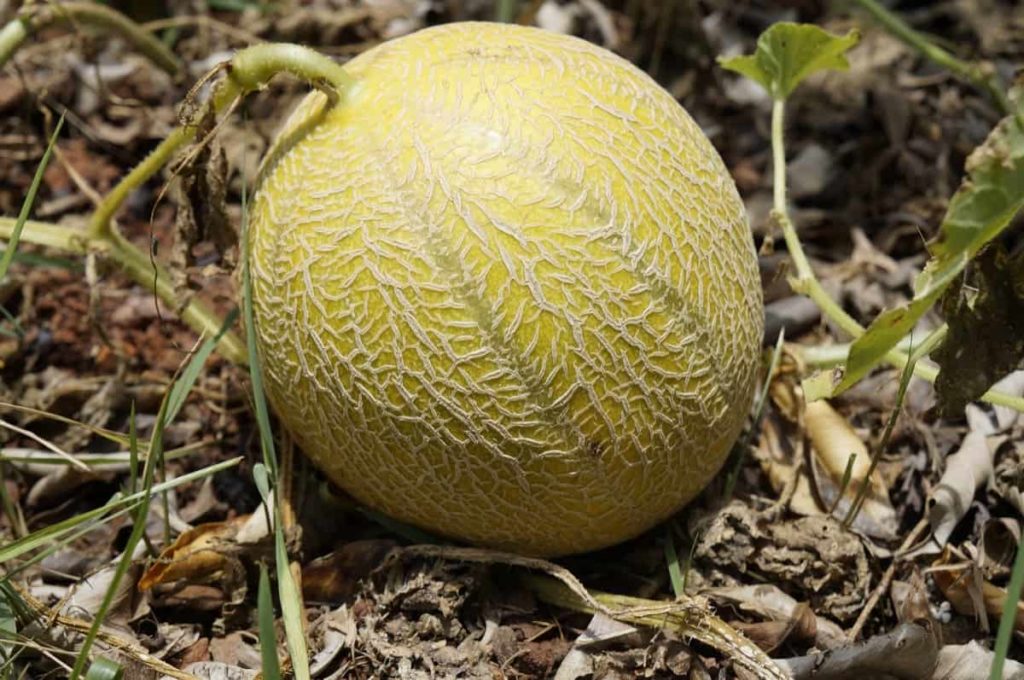
Powdery mildew is a fungus disease that causes white spots or lesions on the cantaloupe plant’s leaves. Powdery mildew won’t stop a cantaloupe plant from growing but will reduce yields over time. Treating powdery mildew using organic fungicides, such as a copper fungicide or a DIY combination, is possible if you catch it early enough. Mix 1 tablespoon baking soda, 1/2 teaspoon liquid soap, and 1-gallon water, then spray over plants.
Prune and overwinter your cantaloupe plants
Once harvesting starts, remove the vines’ tip buds to encourage fruit production. Some flowers can be lost, but those fruits will be worth it. The surviving melons, though, ought to grow bigger and better. To ensure your containerized cantaloupes have enough drainage, use a potting mix that includes perlite or vermiculite.
Composting the soil might also be beneficial for your plants. It shouldn’t be required to repot the plant. When repotting a cantaloupe, ensure the container is large enough to hold the plant until it has reached maturity. The life cycle of cantaloupe, an annual, takes only one growing season to complete. It’s not cold hardy enough for winter. Consequently, there is no need for any upkeep throughout the winter months.
Don’t make mistakes while harvesting
Different types of cantaloupe have different harvest windows, so it’s important to research your plant’s specific needs. Look for a few specific indicators to know when the fruits are ripe for picking. The outside will start losing its green color and developing a brown one first. Fruit should readily twist off the vine thanks to a split in the stem at the point where it meets the fruit.
On average, ripe fruit will fall from the vine when picked, but unripe fruit will likely require additional time to mature. To pick the ripe fruit, twist it off the stem. Take care not to knock down the other branches of the vine, where the fruit is still setting. For up to a week, whole fruits can be kept at room temperature without going bad. Frozen or refrigerated fruit will keep fresh for longer than the cut fruit.
Frequently asked questions about cantaloupes
How do you encourage cantaloupe to grow?
Cantaloupes thrive in full sun and soil temperatures of 70 degrees or above. Plant your cantaloupes 36 to 42 inches apart in rich, well-drained soil since they will spread out. Growing cantaloupes requires many nutrients, so add compost or other organic waste to your soil. For optimal results while growing cantaloupes, use a soaker hose or drip irrigation to maintain a consistently moist soil but avoid watering the leaves. Ensure the ground is well-mulched and weeds are taken care of before the vines emerge.
Get the young fruit off the ground and out of harm’s way. A little flower container inverted to serve this purpose works well. Sweeter fruit will develop if you let your plant have enough healthy leaves and don’t nip off the shoots. Pinch off young fruits as they develop but leave the biggest one on the vine for optimal taste. Cantaloupes are ready to be picked when they have reached peak ripeness and the netting is visible.
In case you missed it: How to Grow Green Chilli Peppers Faster: Best Tips to Increase Flowering, Fruiting, and Production Yield
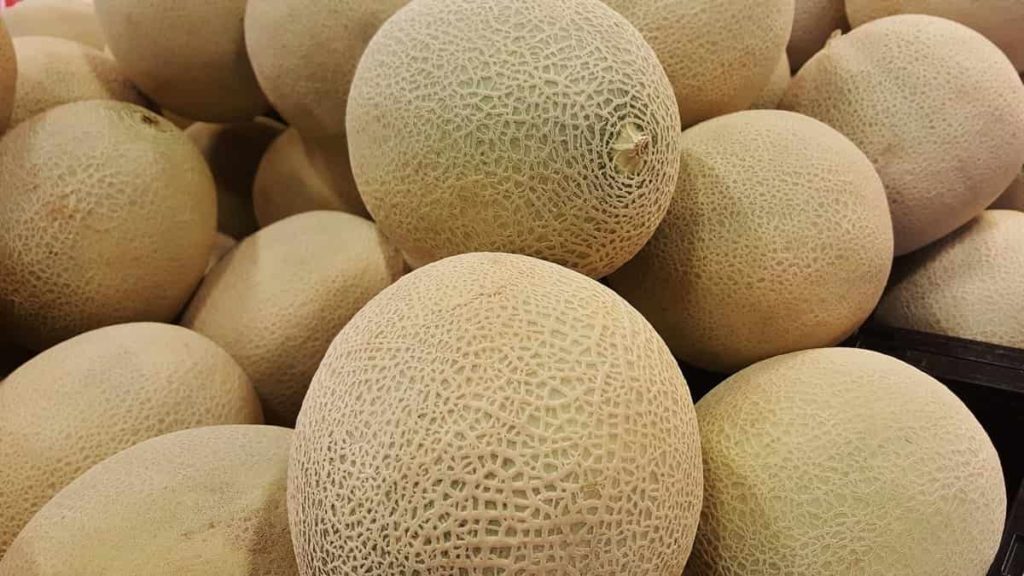
How long does it take for a cantaloupe plant to grow?
Cantaloupe seeds should be planted in warm, sunny soil with good drainage. Please don’t hurry the process; they take around 85 days to reach maturity. Only plant seeds if the weather forecast calls for temperatures of 50°F to 60°F. Seeds should be planted in clusters of two or three, separating each cluster by at least two feet. Once the seedlings have emerged, you should only keep the healthiest one from each cluster.
You can sow the seeds inside containers a few weeks before your region’s average last frost date. However, melons are very sensitive to root disturbance, which can cause the vine development to be hindered if you are not cautious while moving them outside. When pulling weeds, be careful not to uproot cantaloupe seeds or vines.
What is the best fertilizer for cantaloupe?
When transplanting cantaloupes, use a starting solution of 3 pounds of 10-34-0 (or an equivalent) in 50 gallons of water to encourage quick development. The solution should be applied at about half a pint per transplant. Pop-up fertilizers, such as 10-34-0, can be used at a rate of 100 to 150 pounds per acre to newly sown or transplanted cantaloupes in the spring to encourage rapid early development, particularly in chilly or cold soils.
Pop-up fertilizer should be spread 2 to 3 inches along the row and below seeds or roots. Then, either (1) apply the potassium in two bands, with one band 2 to 3 inches to the side and the other band 2 to 3 inches below the level of the seed or plant roots, or (2) mix the potassium into the bed before transplantation. Several studies have demonstrated banding to be more successful than field-wide broadcasting.
When using the modified broadcast approach, nitrogen, potassium, and other micronutrients indicated before planting are distributed in the bed area alone rather than over the whole field. Cantaloupes, for instance, are usually planted or seeded on 72-inch spacing, and then a swath of fertilizer (30 to 48 inches wide) is spread evenly across the bed from center to edge. Rototilling helps get some fertilizer down to the root zone and prevents it from washing away in the wind and rain.
The remaining suggested potassium treatment can be spread across one to three applications. Banding it along the space between rows immediately before the growing root tips is a good place to do so. In most cases, sandier soils benefit most from the largest amount of treatments. Very sandy soils may need either more N or more frequent treatments. Cantaloupes only need 80-100 pounds of nitrogen per acre in Piedmont, the Mountains, and the Limestone Valley.
Rainfall, irrigation, soil type, plant population, harvest season length, technique and timing of treatments, and other factors can all affect the needed N rates for a given season. For typical Coastal Plain soils, 1/4 to 1/3 of the necessary nitrogen should be (1) administered in two bands 2 to 3 inches apart and 2 to 3 inches below seed or plant roots or (2) integrated into the bed before transplantation. Several studies have demonstrated banding to be more successful than field-wide broadcasting.
In case you missed it: How to Grow Cucumber Plants Faster: Best Tips to Increase Flowering, Fruiting, and Production Yield
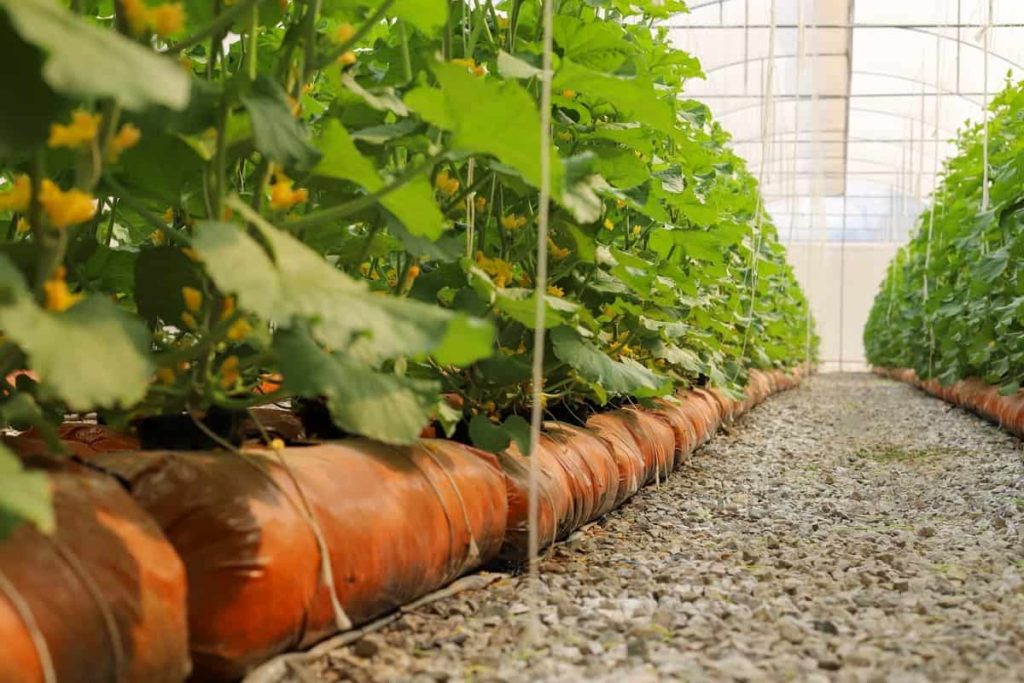
Do cantaloupes need much water?
You’ll want to give your cantaloupes plenty of water, but you don’t want to drown your garden. Moisten your plants by one to two inches weekly, but never water the leaves since this can encourage powdery mildew. Once the fruit develops, you may cut down on watering since drier weather results in sweeter melons.
Using black plastic mulch has several benefits, including reducing the number of weeds in your garden, retaining soil heat, and protecting your fruits from contamination. Most cantaloupe seeds germinate in warm soil between 65 and 70 degrees Fahrenheit temperatures. The black plastic protects your plants from the sun and helps keep moisture in the soil.
How do you make cantaloupe sweeter when growing?
Before planting melons, add four to six inches of composted manure into the soil. This will promote healthy development. Then, every 3–4 weeks, apply a well-balanced organic. Compost gives not only a wealth of nutrients but also some additional heat. Thus some gardeners choose to grow melons directly in their piles.
Conclusion
Growing cantaloupe should be simple if you live in a warm environment that cantaloupe likes and give the plant enough water. You’ll need a large enough garden to accommodate the sprawling vines. Cantaloupe is annual, meaning that the vines will die after harvested fruit. In other words, you need to start again every year with fresh seeds or seedlings.
- Sheep Farming Business Plan for Beginners
- Aquaponic Farming at Home: A Step-By-Step Guide
- Profitable Village Farming Business Ideas in 2024
- High-Yield Aquaculture: Fast-Growing Fish for Farming
- Effective Fish Pond Construction Techniques for Beginners
- Irrigation and Water Management in Pineapple Farming
- Blossom to Harvest: Mastering Flowering and Pollination in Papaya Farming
- Pig Fattening Essentials: From Selection to Sale for Beginners
- Raising Wagyu Cattle: A Complete Guide for Premium Beef Production
- Soil Types and Their Water Holding Capacity
- Optimizing Irrigation Schedules for Coconut Groves for Enhanced Yield
- Espresso Your Garden: Coffee Grounds for Healthier Acid-Loving Plants
- The Best Soil Mix for Snake Plants: How to Mix Your Own Snake Plant Soil
- Green Thumb Success: Expert Tips for Cultivating Greenhouse Beans All Year Round
- Bloom All Year Round: The Ultimate Guide to Indoor Hyacinth Care
- Eco-Friendly Gardening: How to Make Liquid Fertilizer from Kitchen Waste
- Ultimate Guide to Grow Anise in Pots: Explore Seed Propagation to Harvesting
- Guide to Raising Chester White Pigs: Discover Breed Facts to Growth Management
- Mastering the Elegance: The Ultimate Guide to Weeping Cherry Tree Care, Planting, and Maintenance
- Ultimate Guide to Planting Garlic in Grow Bags: Growing Strategies for Beginners
- How to Fix Spider Plant Leaf-Related Problems: Natural and Organic Remedies
- 10 Reasons Why Your Tulsi Plant is Shedding Leaves: Home Remedies and Solutions
- Optimizing Growth and Yield: The Advantages of Palm Bunch Ash Fertilizer
- Utilizing Neem Oil Extract as a Natural Pesticide for Hydrangea
- From Soil to Harvest: Various Ways in Which Farmers Can Use AI Tools
- Steps to Encourage and Induce Citrus Flowers: A Comprehensive Guide
- How to Fix Snake Plant Leaf-Related Issues: Natural and Organic Remedies
- Transform Your Garden into a Fragrant Oasis with Raat Ki Rani (Night Blooming Jasmine)
- Discover the Ideal Chicken Breeds for Philippine Farms
- How to Create a Poultry Egg Farm Business Plan for Profits
- Grow Lemon Cucumbers Like a Pro: Insider Techniques for Bountiful Yields
- Ultimate Guide to Caring for Your Pink Princess Philodendron: Tips for Thriving Variegation
- Areca Nut Profit Per Acre: Calculating Yield and Cost of Cultivation
- How Kaveri Chicken is Becoming a More Profitable Breed in Indian Backyards
- Transform Your Barn: 9 Steps to Convert a Horse Stall into a Chicken Coop
- Exploring Suffolk Sheep Disadvantages with Limitations and Challenges
